
First Nacra 15 on San Francisco Bay
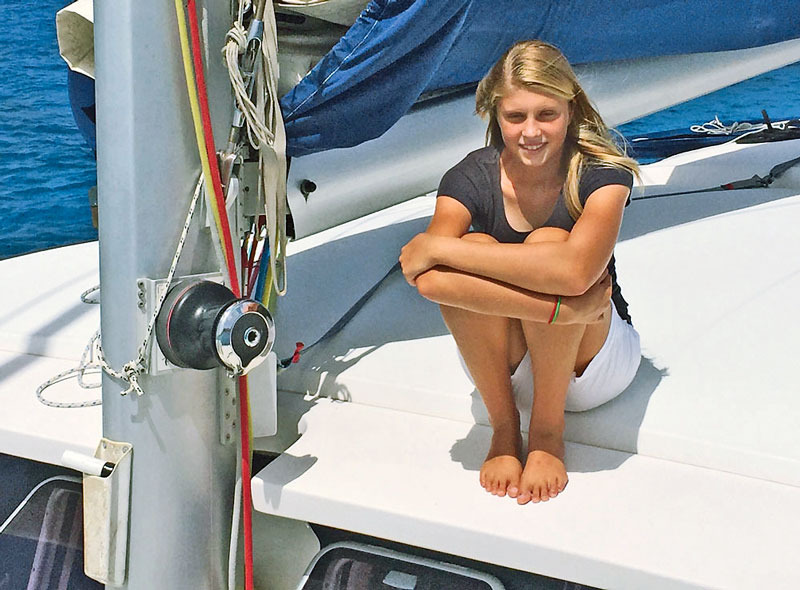
©Latitude 38 Media, LLC
Theodora ‘Teddy’ and Helen Horangic were featured in Latitude 38 while on a 2.5-year cruise with their family on the Outremer 49 catamaran Liladhoc. They were in St. Barth when the Wanderer interviewed them for the June 2015 issue, and Teddy even appeared on the cover. The girls checked in recently with word of their latest adventure.

"My sister and I have been back in school since September (8th and 9th Grade)," wrote Teddy. "When we returned, we upgraded from the Optis we carried on the bimini of our catamaran to sailing c420s together with Peninsula Youth Sailing Foundation in Redwood City. We got fourth at Orange Bowl in Miami at Christmas."
Now they’ve upgraded to the new Nacra 15 catamaran, which was developed last year as a youth trainer for the Olympic-class Nacra 17. "We just brought the first one ever to the San Francisco Bay," said Teddy. "Two more have already been purchased by other owners and should arrive soon. Right now they have curved daggers, but they will have foiling daggers by the fall. We saw Pete Melvin, the designer, testing them in L.A. where we picked ours up."
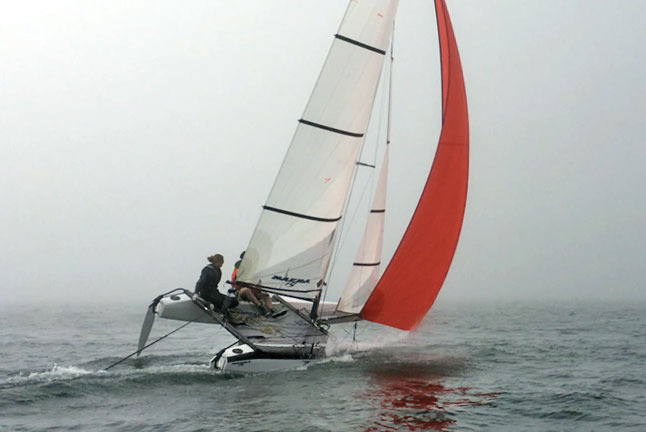
"This boat was introduced to the World Championships in 2016, and will appear for the first time in the US Championships in June and the first time in the Youth Olympics when it comes around again next year," explained Teddy.
"We are hoping that other kids and parents get into them and buy more when the next shipments to the US arrive in June and December. Right now there are only 10 in the USA. Five of them, including ours, will gather for a clinic at St. Francis Yacht Club on May 13-14, where anyone can try it out."
The Horangic sisters want to find sailing partners for each of them in the Nacra, since they are both on the light side. In particular they are looking for kids around 140 lbs. who are tall, strong and agile and want to practice five days a week out of Redwood City for the Youth Championships in June. "We would even take someone with no sailing experience, just a really strong interest and dedication." If you’re interested, contact us and we’ll pass your info along.
South Pacific Bound
We always love spending time in our booth at the Pacific Sail & Power Boat Show as we reunite with old friends, make new friends and connect with readers and sailors from all over the West. At this year’s show, which concluded yesterday, the range of sailors we spent time with included people who enjoy doing beer-can racing on the Bay, as well as others who were about to sail across the Pacific.
Pictured here are Robert D. Tinus and Terry Berger of the Hans Christian 34 Cleo II, who attended the show to do some final preparation for a crossing from Benicia to the Marquesas with third crew member, Bruce Hutchins, as part of the Pacific Puddle Jump. Their visit to the Latitude 38 booth at the show earned them an official Pacific Puddle Jump burgee — a memento usually reserved for those who attend one of our two Puddle Jump Sendoff Parties at Mexico’s Vallarta Yacht Club or Panama’s the Balboa Yacht Club.
©2017Latitude 38 Media, LLC
Meanwhile, Dutch Puddle Jumpers Wietze van der Laan and Janneke Kuysters of the Bruce Roberts 44 Anna Caroline will be setting sail — possibly today — from Emery Cove Marina bound for the Marquesas. Janneke recently authored two stories for us, Citizen Sailor/Scientists in the December issue and the America’s Cup story in our current April issue.
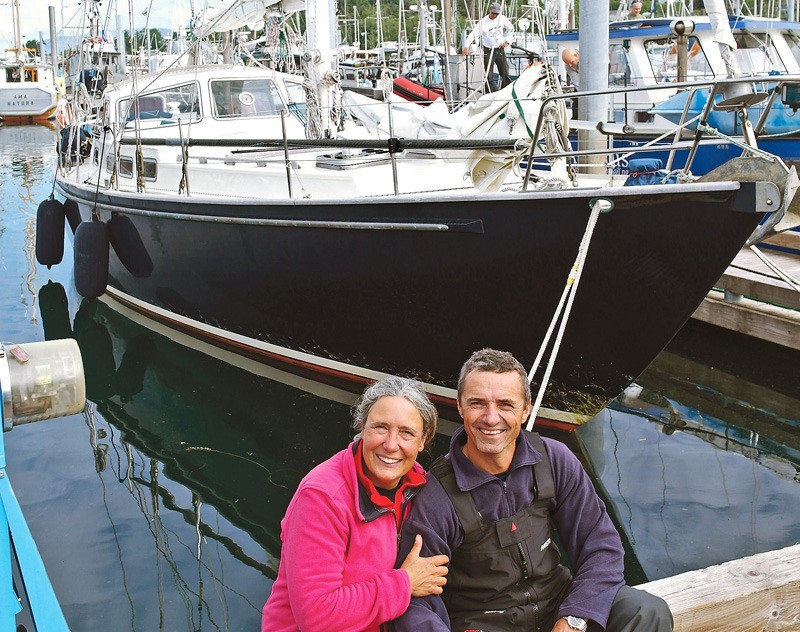
©2017Latitude 38 Media, LLC
Unlike more formal rallies, Pacific Puddle Jump participants depart from various locations along the West Coast of the Americas, anytime between late February and early June. Many of them will reunite at the 12th annual Tahiti-Moorea Rendez-vous on June 23-25, in Tahiti.
Look for additional updates on this year’s Puddle Jump migration both here and in the pages of Latitude 38 magazine (which is always free, and downloadable from our website).
Should Sailors Assist or Stay Clear?
This weekend, the Coast Guard plucked two kiteboarders from San Francisco Bay in separate, unrelated rescues.
On Saturday, the Coast Guard recovered a kitesurfer and his gear off of Coyote Point and returned him to shore around 5 p.m. About an hour later at Crissy Field, a rescue team from Golden Gate Station pulled a kiter out of the water near Anita Rock. The man was taken to Pier 45, according to a Coast Guard press release.
These rescues remind us of the potential dangers of kite- and windsurfing on the Bay and the useful role that sailors can play when practicing thoughtful seamanship.
At any given time, the kiteboarders and windsurfers who are out on the Bay will possess a wide variety of skill levels, and even the best are prone to equipment failure, injury or bad luck. Technically speaking, kite- and windsurfers worth their salt should be able to get themselves out of trouble, yet sailors occasionally find themselves in a position to assist or rescue a downed boarder.
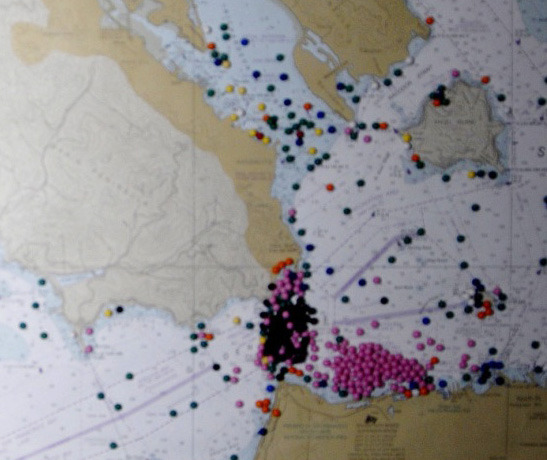
©2017Latitude 38 Media, LLC
"Any decent kiting school will go over the self-rescue," said Ovi Banuta of Kite415, adding that an avid kiter should have no problem getting back to shore in the event of an equipment failure. "Our school puts a lot of emphasis on it. The self-rescue is also an exercise you want to practice multiple times in many conditions."
Banuta said some "weekend warriors," lured by the apparent safety of shallow water or proximity to shore, might not realize the importance of the self-rescue.
But what role do or should sailors play if they see someone stranded in the water? If you do approach a downed kitesurfer, remember that there are four 25- meter lines floating in the water (perfect for fouling a prop or wrapping around a keel). If the kiter is not able to secure their lines, boat skippers must be sure to give this gear plenty of room.
And remember, just because someone is down and apparently flailing doesn’t necessarily mean they’re in distress. For example, I have self-rescued on my windsurfer many times, but have had boats circle me, kicking up a wake to ask if I’m OK. The thought is always appreciated, but if you can keep your distance when hailing someone awkwardly paddling their board, please do.
Regarding the rescues this weekend, the Coast Guard said, "These cases are common in the San Francisco Bay… We advise kiteboarders to keep a marine-band radio with them, as that is the quickest way to contact rescue services."
New Battle over Largest Sailing Yacht
A few years ago there was a hotly argued debate over which was the largest privately owned sailing yacht in the world. The contenders were the 289-ft Maltese Falcon, owned by Tom Perkins of Belvedere; the 292-ft Athena, owned by Jim Clark of Silicon Valley; and the 310-ft Eos, owned by Barry Diller and Diane von Furstenburg of New Yawk.
While Eos was certainly the longest, there is a good argument that Falcon, the shortest of the three, was actually the largest. That argument was presented in Wikipedia: "According to the San Francisco Bay Area sailing magazine Latitude 38, the Eos is longer overall than her nearest rival, the Maltese Falcon. However, much of the length of Eos is in the bowsprit, and although she is slightly beamier than the Falcon, the Maltese Falcon is 14 feet longer on deck and over 20 feet longer at the waterline.
"Which one is bigger? Well, it depends on how you measure it. If the bowsprit counts (and it usually does), then the Eos wins," opines the YachtPals website.
"However Latitude 38 begs to differ. They ‘consulted with sailing experts from around the world at the Le Select Bar here in St. Barth,’ who explained that the length at the waterline and length on deck are ‘the real measure of size,’ making Maltese Falcon the largest sailing yacht."
However, the argument of the big three mentioned above became moot when Andrey Melnichenko launched his 465-ft — no kidding! — yacht a few months ago. Some observers, the Wanderer included, argued that A should be disqualified from any consideration based on the fact that she is as hideous-looking as his previous boat, the 300-ft motoryacht (also named) A, was beautiful and innovative.
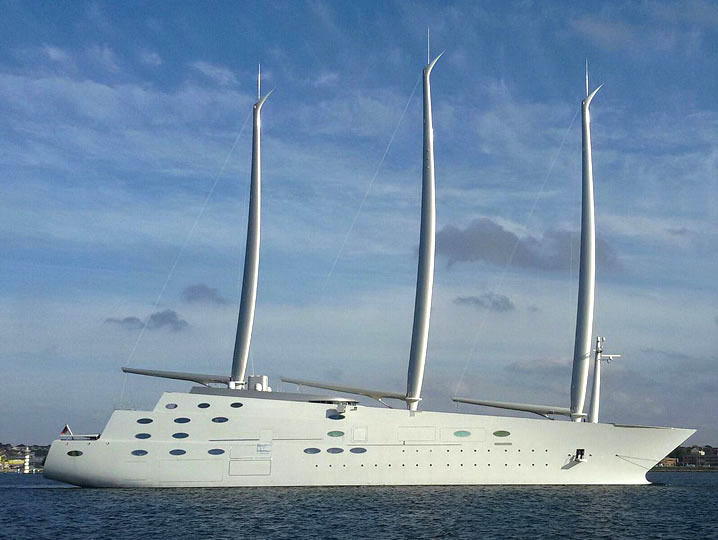
But with the recent launch of Oceanco’s 347-ft Black Pearl, the argument against A has gotten more traction. The reason is that when A was launched, she was self-described as being "sail assisted," not as a sailboat. On the other hand, Black Pearl, like Maltese Falcon, is equipped with the unique Dyna-Rig on which Tom Perkins gambled about $10 million developing, and the Pearl will really be able to sail. Plus, she’s gorgeous.

So does A qualify or is Black Pearl the largest? We’ll be swinging by the Le Select this afternoon and let you know the official decision. But we’d like to hear your opinion, too.
